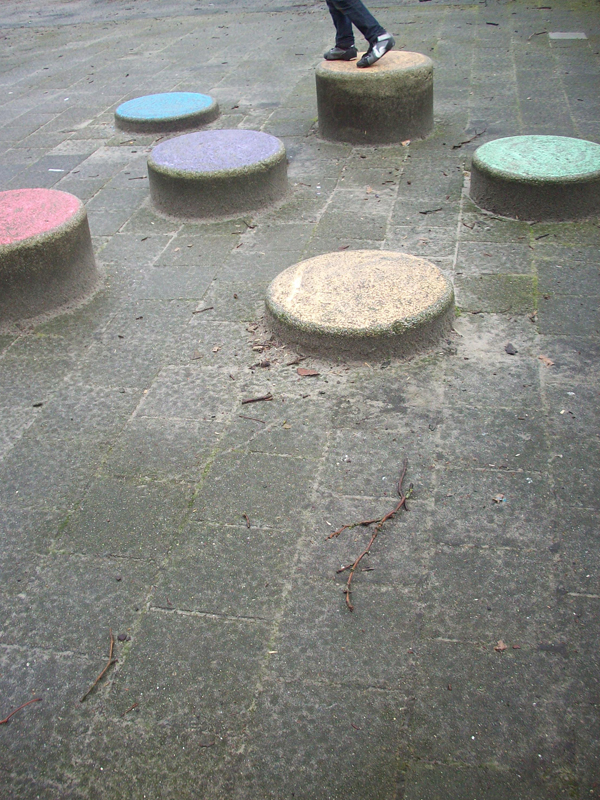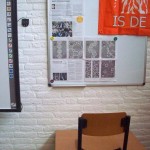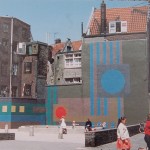Took the little girl to school today. She had taken Straatnieuws to school earlier, and…
Playground jump
Of all the pictures I took last week, there is this one that keeps coming back to me. Taken at Bertelmansplein in Amsterdam, van Eyck’s first playground, it shows my little girl jumping on one of the very few original ‘van Eyck’s’ . It has nice composition, tells a story about van Eyck and about playgrounds today, also my personal angle is there because it is my little girl jumping from post to post. It is reasonably abstract, which I like, and is between perception (‘I’ position) and meta-perception (overview position). Since experimenting Tractie (see an example here) I keep seeing things ‘from above’ and the pictures I take are taking on that quality, too. Strange!
Will have this one printed fairly large and put in on the wall to see if it stays good.
Some notes on games from my MaHKU thesis:
Wittgenstein drew a simple scheme depicting an eye and its field of vision. And then said: “our vision does not look like this’. Thus, he concluded, the person that perceives the world does not belong to the world, but is its boundary. Wittgenstein, ‘Tractatus logico-philosophicus’ section 5.6331
It is difficult to perceive perception – we are bound by and to our position in space and time. To position ourselves, we have to do something that is by its nature contrary: we must both see ourselves in the here and now and abstract ourselves from it. Abstraction in time is handled by the narrative of identity: the story of who we are, where we came from and where we think to go. Abstraction in space is handled by the mental map we construct, depicting our surroundings and placing ourselves on it so as to position ourselves in respect to other people, objects and landscapes.
Games, when analyzed for their perceptual requirements, turn out to be quite complex situations. When playing a game, and playing it well, one alternates between – or performs simultaneously – at least three different modes of perception.
The first mode is that of individual perception: where am I situated, what does my environment look like, and what actions am I asked to or able to perform? Games act as ready-mades in this respect, as models for action that enable us to situate ourselves at a glance and establish immediate relations with other players. They also enable us to draw upon a store of acts and decisions learned when playing games before. These may be as simple as the series of rules that enable us to recognize a game of hide and seek and to play this particular game, or as complex as our understanding of the game of chess and our store of knowledge about chess variations and moves.
This store of knowledge enhances our pleasure in the game and provides a framework that frees us to focus intently on the play experience itself. The predictability of games make them ideally suited for the trance-like playing that is the hallmark of the second mode of perception: immersed perception. When immersed in a game, players’ perception, their reactions and interactions all take place within the framework of the game. This is the state in which we can only play when not knowing the rules any more, forgetting everything we were ever taught.
A good example of this we find in the earliest computer games. These games drew their cues heavily from a singular scheme, turning them into glamorized versions of video arcade games. However simple they may look to us now, the early game developers hit their mark by founding their first games on two essentials: a recipe for interaction that was engrossing, and normative narratives borrowed from already familiar forms of entertainment. Their very simplicity and predictability allowed people to give themselves up to the game.
Then there is a third mode of perception. Full participation in a game requires immersion, while at the same time it enhances individual perception to a point where perception cannot be fully anticipated or controlled by the individual. Gadamer asserts the primacy of the play over individual consciousness: “The players are merely the way the play comes into being.” The game thus becomes self-moving, requiring us to play along with what we bring into being. It takes us out of ourselves and makes us part of a larger whole. Perception of this larger whole I will call meta-perception: the point where the individual becomes part of a larger system, and this larger system becomes part of the individual. “This is the moment you are ‘ín form’ in both senses. It feels good and there is this whole hectic feeling of extension into the world that is being ‘informed’. “ David Winner, Brilliant Orange, page 71.
[[ Of course, any kind of perception is more and more dependent on the media we use. Media, as defined by Mulder, are “a man-made technical or artificial extension of a capability of the body”. Mediatheory, page 17 A bicycle thus becomes a technical extension of the capability of the body to propel itself in space. Media enable us to see more, to do more, to remember more and to communicate with each other over distance and time. The luxury of using media is that with time and use they become transparent to us – we conveniently forget that the medium is there, and make no difference between direct perception on the one and mediated perception on the other hand. This is where play could be of use: it makes us switch between different modes of perception, thus recalling our attention to the fact that our perception is in fact mediated.
| « Small interventions | <-- previous post | next post --> | The Homecoming – Pinter analysis » |
|---|








